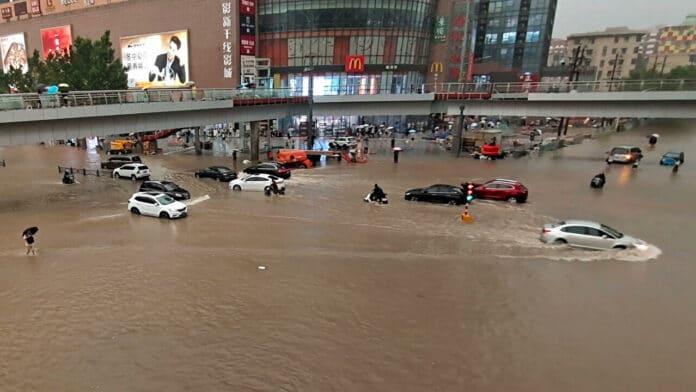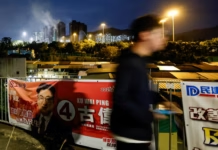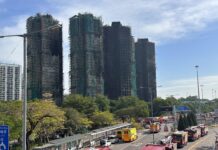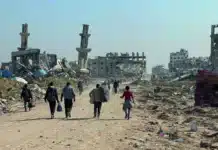“Don’t use natural disasters to cover up man-made disasters!” – Chinese netizens
Qiu Qing, chinaworker.info
On 20 July, a heavy rainstorm in China’s Henan Province (600km to the south of Beijing), with alarming flooding, caused extremely serious economic losses and over 300 deaths. This disaster vividly shows us, once again, how the Communist Party of China’s (CCP) autocratic bureaucracy exacerbated a disaster step-by-step, causing avoidable casualties.
Of course, this disaster is not an isolated event on the planet. Almost at the same time, floods also occurred in western Germany and Belgium, and extreme high temperatures and wildfires occurred in western United States and Canada. These reports have repeatedly and unambiguously impressed the harsh reality upon us: the climate disaster has already started.
In contrast, however, CCP officials are all content to blame this disaster on what they characterize as “extreme weather”, but interestingly, official propaganda seldom mentions the correlation between this disaster and the climate crisis. China is the world’s largest emitter of greenhouse gases, accounting for 27 percent of total global emissions. In the past year, due to the global pandemic, the production capacity of heavy industry has increased, and China’s carbon dioxide emissions have increased by 15 percent, setting a new record.
On 22 July, Ren Guoyu, the chief expert of China’s National Meteorological Center, directly denied the relationship between the Zhengzhou rainstorm and the climate crisis, saying that the cause was the “abnormal planetary atmospheric circulation” caused by twin typhoons. But as we all know, frequent typhoons are an important sign of the climate crisis. The Chinese government does not blatantly deny the climate crisis like Trump did, but hopes to limit the climate crisis as exclusively a topic of diplomatic negotiations to avoid triggering a domestic mass movement that looks to emulate the global climate protests. But this flood has already awakened many Chinese people: the climate crisis is not something far away from me!
The CCP’s propaganda department has spared no effort to emphasize that this is a “one-in-a-millennium” (some departments even call it a “one-in-five-thousand-years’ rainstorm”) in an attempt to downplay the responsibilities of the politicians. Although this disaster reminds us of the urgency of our climate crisis, the damage caused by the CCP bureaucracy is no less than the disaster itself. The Zhengzhou Meteorological Bureau issued five “red rainstorm warnings” (the most severe level) from 19 to 20 July. This means, according to the official instructions of the Central Meteorological Bureau, that the government and relevant departments should be prepared for contingencies, including the suspension of classes and work, etc. However, the Zhengzhou Municipal Government was unprepared for this, and failed to announce the suspension of work or classes, and required the city to operate as usual during the whole day of heavy rains.
A member of staff of Zhengzhou City Flood Control and Drought Relief Headquarters was interviewed by Southern Weekly reporters and during the interview, stated “Early warning is not a law, but mainly a suggestion. There are always some (companies) who are not very conscientious and will require employees to go to work as per usual.” The Meteorological Bureau staff pointed out that they are only responsible for providing weather warnings and do not have the right to decide to suspend work and classes, because the Ministry of Management issues such orders. As for the Emergency Management Bureau’s response, the decision to suspend work and school “can only be done after the approval of the headquarters at all levels”. These responses fully expose the rigidity of the undemocratic bureaucracy. By 20 July, the entire city was partially submerged in water, and flooding in the streets had washed away pedestrians and even cars. The disaster was irreversible, but the bureaucracy has still not advised the populace to shelter in a safe place. If the government had ordered the suspension of work and classes in a timely way, then commuters would not have had to leave home for work that morning in the face of seriously bad weather.
Therefore, the natural disasters of the day, and the disastrous actions from the bureaucrats that followed upon them, caused a doubled disaster. One of the most serious casualties was the Jingguang North Road Tunnel. From the afternoon to the evening on that day, it happened to be the rush hour for people heading home. More than 200 cars were blocked in the middle of the tunnel and could not move. At the same time, the tunnel began to take on water, and the water flooding steadily increased. It was reported that the speed of the submergence very rapidly gained pace, and the whole process only took a few minutes. This section of the tunnel was completed in 2011, and as early as the launch of construction, some engineers pointed out that this section is low-lying and used to be a swamp. They warned that it is not a suitable location to build a tunnel, and it is very likely to be flooded. But the government and engineering authorities ignored this warning.
This happened in the context of the so-called “infrastructure madness” craze in various parts of China over the past ten years or so, which has led to huge investments in infrastructure, but many of these are simply white elephant projects to satisfy targets for bureaucrats’ achievement, with worrying levels of safety and quality. At critical moments, these projects have frequently been disregarded like water off a duck’s back.
For example, just over a month before the disaster, the official website of the Zhengzhou City Administration stated that the construction of the first phase of the Zhengzhou smart tunnel (the Jingguang Road Tunnel Pilot), which was launched in 2020, was finished. Accordingly, in the “smart” system, if an emergency occurs, accurate and rapid search and rescue can be effectuated. The Southern Metropolis Daily also stated that the Jingguang Road Tunnel had just been overhauled half a year ago, and the maintenance items included drainage facilities, fire fighting and electrical equipment. Two months ago, a flood control drill was also carried out. At the same time, it was equipped with two drainage stations. When the accumulation of water in the pool reaches a certain depth, the drainage station was supposed to be automatically activated to drain water before it could accumulate. However, these measures all failed miserably in the face of this real-life disaster.
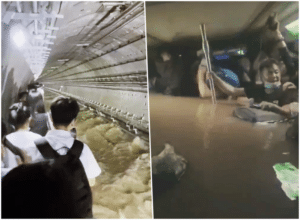
The other hardest hit place was Zhengzhou Metro. On the evening of 20 July, many video images taken by people trapped in the subway were circulated on the Internet. It can be seen from the videos that the metro carriage was already full of mud and water, and part of the water depth had reached the necks of passengers. The water level outside the carriage was even higher and the current was turbulent. In the face of these events, the public questioned why the metro continued to operate, thus becoming a death trap. The director of the Security Department of the Zhengzhou Metro Company claimed that suspension of services needs to be reported to the Commission and Emergency Management Bureau through the subway operating company. Once again, we see the hesitation and inertia of the bureaucracy.
What is more frightening is that this bureaucratic mentality of “waiting for the superiors’ approval” affects the entire society – just like Wuhan in the early days of the outbreak of the Covid-19 pandemic. People and staff who survived the Zhengzhou Metro tragedy said that from the beginning of a slight accumulation of water in the train tunnel, to the train being stopped by the flooding of the tracks, the carriage began to seep until the water flow outside the car was so turbulent that it was impossible to escape. It took three to four hours. But in the course of these three to four hours, from the drivers to the station masters, to the subway management department, there were no contingency measures. They all waited mechanically for “superiors’ orders”. The disaster relief worker, Mr. Zhang, told Deutsche Welle that he had a friend and other passengers trapped in a carriage that was filled with water to their shoulders. “There was no death in the car he was in, but he saved himself by fleeing.” Conversely, the drivers, who were also in danger, just watched the water inside and outside the carriage gradually rise, but they did not dare to organize the passengers for an evacuation, instead only sat on their hands and waited for instructions. It reveals that the severe bureaucratic mentality has even trumped some people’s most basic instinct, making people afraid to save themselves even in the face of “imminent” life threatening danger. This only shows that the bureaucracy is more terrible than the flood.
The official media also behaved very badly in the metro disaster. At about 9pm that night, with a large number of people still trapped and still waiting for rescue, the official media including China Central Television (CCTV), Global Times, and the official Weibo of the Zhengzhou Municipal Government, etc. could not wait to send out news: “All the trapped passengers have been rescued and there is no danger to their lives.” The news caused despair for passengers who were trapped in the carriages and still able to receive external messages through their mobile phones. Thinking that the Search and Rescue Teams had given up on rescuing them, they thought they could do nothing but remain in the train and wait for their deaths. The bureaucrats created this unnecessary trauma and heartbreak so they could save face and look like they were back in control.
The bureaucrats falsifying the reality and ignoring the feelings of the trapped people and their families aroused fierce criticism from the masses. Then the official media decided to admit that there were still people who had not been rescued, and that rescue work was still ongoing. Regarding the number of deaths, the official media claimed 14 people were killed in the subway flooding. However, this number is also questioned. Some people believe that in the case of turbulent water flow outside the car and high water level, passengers would soon face hypothermia and hypoxia even if the car is still not completely submerged. Rescuing the hundreds of passengers on the entire train has proved to be extremely difficult work. According to the Henan Business Daily, the husband of a trapped passenger said that when he reached the subway station near the place where his wife was trapped and asked the staff for help, “The staff did not know how critical the condition inside the carriage was.”
But the disaster caused by bureaucrats did not stop there. At 10.30pm on the 20th, the People’s Daily published an article stating that the Zhengzhou Changzhuang Reservoir would release floods that night. However, Zhengzhou government’s official statement said that the reservoir had already discharged flood waters at 10:30am on the 20th. Some people in Zhengzhou photographed the city centre at noon on the 20th, showing that in the city centre, the road was suddenly submerged by floods and rapids in less than 30 minutes, and people and cars were swept away by the rapids. This scene did not look like a gradual increase in stagnant water caused by heavy rains, but more like a flash flood. Therefore, the public doubted whether the government bureaucracy rushed to release the flood waters without informing the public and without arranging for evacuation, which caused the urban area to be flooded, creating an impossible situation for everyone.
Soon afterwards, the official media suddenly changed their tone to deny the news of the flood waters release, making the truth of the incident even more confusing. But what is certain is that in a village near Weihui City, about 80 kilometres to the north of Zhengzhou, at 4am on 21 July, some unidentified individuals attempted to undermine and breach the local dyke while the residents were sleeping. Fortunately, the residents spotted them and they were driven away before they could damage the dyke, after which the residents braved the heavy rain to guard the dam 24/7 to prevent any further attempts to destroy the dyke. But what is intriguing is that on 25 July that is, two days after the rain stopped, the urban water accumulation in Weihui City did not decrease but increased, and the city’s flood water level soared, changing from partial accumulation of water to the entire city being flooded. People in Weihui suspect that the government released floods without prior notification or arrangements for evacuation. The disaster by the bureaucrats continued after the rain had stopped. According to news on 28 July, when the floods in Weihui City had not yet receded and volunteer rescuers were still wading through the water to search for the victims, the Weihui Municipal Government suddenly turned on electricity and at least eight volunteers were electrocuted. It is currently unknown whether they are alive or dead.
The rainfall disaster and bureaucratic disaster caused widespread dissatisfaction and anger among the people. After the heavy rain, people gathered around the submerged Jingguang North Road Tunnel and were driven away by police at the scene. Especially when the tunnel was drained and the vehicles in the tunnel started to be towed away, the police used more brutal means to disperse and even beat onlookers. The motivation for these heavy-handed tactics is likely that the bureaucracy wants to cover up the actual number of casualties in the tunnel.
On 27 July, a large number of people from Zhengzhou City placed flowers outside the Shakou Lu station of the Metro to mourn the dead. The government immediately sealed off the outside of the station to prevent the people from continuing to mourn and offer flowers. However, that night, some people spontaneously dismantled and removed the barriers, which was cheered and encouraged by other people present at the scene. On the 28th, more people went to mourn the dead, and the piles of flowers stretched all the way to the end of the street. Under strong pressure from the public, the government tolerated the protest and did not re-enclose the station.
But on the other hand, in the face of strong public dissatisfaction, the CCP continues to adopt methods of inciting nationalist sentiments to divert public anger. In particular, the Communist Youth League called on netizens to target reporters from the BBC, CNN, and Deutsche Welle and other foreign media. These reporters said they felt obvious hostility when conducting interviews , and they were obstructed and besieged by some ultra-nationalist agitators. It is believed that some of the people wearing black plain clothes who participated in the obstruction of foreign reporters were in fact the secret police, and they even carried weapons designed to shoot down drones. In its news report that day, CCTV only did cursory reporting on the floods in Henan that were obviously a national concern, but they reported on the floods in Europe at length and in detail.
The people who were awakened by this flood are beginning to realize that this disaster is not only a natural disaster, but also a man-made disaster. The Chinese internet was filled with people commenting, “Please don’t use natural disasters to cover up man-made disasters!” The incompetence and corruption of the bureaucracy magnified this disaster. Only by fully implementing democratic rights and eliminating greed for profits can bureaucratic corruption be completely eliminated. When facing a crisis of natural disasters, the government always prioritizes its own political achievements and economic benefits for those developers with connections to the CCP rather than the safety of the people. The transportation, construction, and urban planning departments should be democratically controlled and managed by the working class. Private capital should not be allowed to infect public works with the profit motive, and the people’s lives must not be left to chance.
This disaster has once again highlighted why the Chinese working class needs independent trade unions. For example, to prevent white elephant projects from endangering peoples’ safety, in addition to democratic control of the construction department, workers would democratically elect safety representatives through a newly established independent democratic union, giving them the right to suspend work (and for students their class) in an emergency, and to veto dangerous projects. The people must also fight from the bottom-up, unite with the working masses worldwide to oppose both capitalism and the bureaucratic dictatorship, which ignore environmental costs for profit, fight the climate crisis with socialist policies, and end the destructive rule of capitalism.

